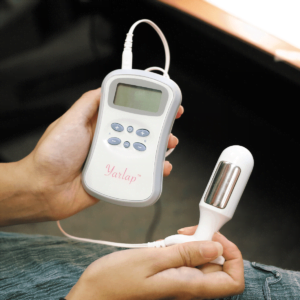Many mothers of newborn children find themselves dealing with bladder leaks. Many are completely unaware that the pelvic floor muscles play the main role in leaking pee when you do an activity. New mothers do not have an easy time controlling their bladders. Urinary incontinence (the medical term for bladder leaks) has been the bane of motherhood’s existence for as long as we can remember. This is why new moms have bladder leaks:
Celebrity mothers like Chrissy Teigen and Kim Kardashian have publicly spoken about wearing diapers post-delivery. Both stated that they had no idea that mothers had to wear diapers, or pads, for weeks after giving birth.
 Urinary incontinence affects a huge number of women. Around 25% (for c-section deliveries) to 40% (vaginal deliveries) of new mothers experience some form of incontinence postpartum.
Urinary incontinence affects a huge number of women. Around 25% (for c-section deliveries) to 40% (vaginal deliveries) of new mothers experience some form of incontinence postpartum.
It is no surprise that childbirth is going to cause some damage/leakage. Many women deal with temporary instances of urinary incontinence during pregnancy because of the increased pressure on the bladder. The resulting pressure from delivery weakens the strength of the pelvic floor muscles.
What is Perineal Re-Education
Perineal re-education sounds like something out of a textbook you would skim over, but it’s actually one of the most helpful things a new mother can do.
Perineal re-education is retraining the pelvic floor to stop the urinary incontinence and leaks at the source. When you deliver a baby with a traditional birth process, your pelvic floor muscles endure a huge amount of stress; unfortunately, not everyone fully recovers from the process, leaving the pelvic floor muscles weak and the bladder unable to fully stretch and contract properly.
Why Perineal Re-Education is So Important as a Mom
Perineal Re-Education, called la rééducation périnéale in France, has been used for decades for new moms. Though still somewhat unknown in the United States, perineal reeducation has been helping French women fight off urinary incontinence since the government began funding it in 1985.
 New mothers are entitled to between 10 and 20 sessions with a gynecologist (or another doctor in a similar field). These sessions typically consist of various different exercises, all of which revolve around contracting the pelvic floor muscles. For example, a French doctor may insert a device with electronic sensors and ask the patient to squeeze as hard as they can.
New mothers are entitled to between 10 and 20 sessions with a gynecologist (or another doctor in a similar field). These sessions typically consist of various different exercises, all of which revolve around contracting the pelvic floor muscles. For example, a French doctor may insert a device with electronic sensors and ask the patient to squeeze as hard as they can.
The sensors determine the strength of the contraction, and over time the contractions are supposed to become stronger, bringing the pelvic floor muscles back to their former glory. This helps explain why French mothers apparently don’t have to worry about leaking urine when they sneeze or cough, unlike their American counterparts.
A link between anxiety and depression with incontinence is incredibly high among women. In fact, this issue is so embarrassing that one study found that incontinence doubles the risk of postpartum depression in women. Truth is: bladder leaks (incontinence) is super common.
Current Bladder Leak Options
Kegels are a longstanding method of regaining control of your pelvic floor muscle. Over 50% of women cannot do a proper Kegel exercise (even with proper training). This is mind-blowing! But it’s because these muscles are really hard to isolate. As reported by the University of Maryland Medical Center, many women are unable to correctly squeeze their pelvic floor muscles on their own. You are not supposed to use your rear end or abs while you Kegel.
This is where Yarlap® comes in to help you effortlessly do a Kegel exercise for you. We take the guesswork out of the pelvic floor muscles. The Yarlap® designer helped design the perineal re-education devices used by the National Health Services in France, Britain, Germany, and Scandinavia. The Yarlap® is much easier to use.
Read: Why Yarlap® Matters
Surgeries to correct the problem can be even more time-consuming, not to mention expensive. A 15% rate of “complications” on approximately 206,000 procedures a year, suggests a discordant patient benefit analysis. With surgery, there’s always a risk of dangerous complications as well.
When it comes to prescriptions, according to the Washington Post, in spite of all the promotional resources, half the women prescribed drugs for overactive bladder stop taking the medication within six months because of the side effects.
Yarlap®: the Simple Solution
The Yarlap® is similar to the perineal re-education devices used by the National Health Services in France, Britain, Germany, and Scandinavia.

Relevium Labs Inc., ©2018
The Yarlap® uses low-level electrical stimulation to strengthen the pelvic floor muscles, not only helps treat urinary incontinence but often heightens a woman’s ability for feminine satisfaction in a way that the most-dedicated Kegel practitioner could only dream about. Our technology draws on work by academic researchers such as Beverly Whipple and Elisabeth Lloyd, has to lead to our president being published in The Journal of Women’s Health, Issues, and Care, and crosses boundaries between sex and medicine.
Unlike the re-education sessions, however, you don’t have to schedule an appointment – you can do it at home in only 20 minutes a day. You do not have to just live with urinary incontinence.



